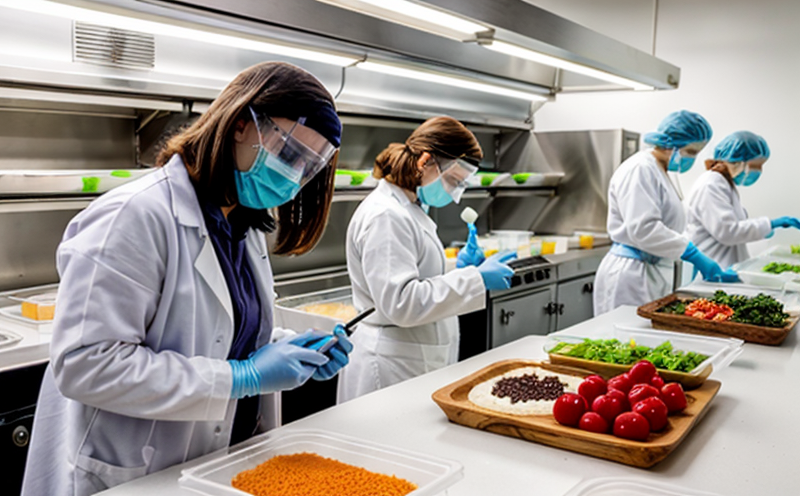ISO 4833-1 Aerobic Plate Count Testing in Food
The ISO 4833-1 standard is a globally recognized method used for determining the total aerobic plate count (TAPC) of microorganisms present in food products. This testing procedure helps ensure product safety and quality by quantifying viable bacteria, yeasts, and molds that may be present.
This test is particularly important in ensuring compliance with international food safety standards, as it allows for the quantification and characterization of aerobic microorganisms. Understanding the presence and numbers of such organisms is crucial in identifying potential sources of contamination or spoilage and helping to maintain product integrity.
The method involves a series of steps including the preparation of agar plates, incubation at specified temperatures, and enumeration of colonies on the plates after growth has occurred. The results provide actionable data that can inform process improvements and ensure product safety.
Compliance with ISO 4833-1 is essential for manufacturers looking to meet regulatory requirements and consumer expectations regarding food safety. It supports a quality management system by providing critical insights into the microbial load within food products, thereby aiding in the implementation of preventative measures against contamination.
The standard applies not only to raw materials but also to finished products at various stages of processing. By adhering to ISO 4833-1, laboratories and manufacturers can ensure that their testing procedures are consistent with international standards, which is vital for maintaining a reputation for quality and safety in the global market.
Understanding the specifics of this test is crucial for those involved in food production and quality assurance. The following sections will delve deeper into the applied standards, benefits, and customer impact associated with ISO 4833-1 aerobic plate count testing in food.
Applied Standards
| Standard | Description |
|---|---|
| ISO 4833-1:2019 | This standard specifies procedures for determining the total aerobic plate count of microorganisms present in food. It covers the preparation of media, inoculation methods, incubation conditions, and colony counting. |
| ASTM E2347-18 | American Society for Testing and Materials standard that complements ISO 4833 by offering additional guidance on the interpretation of results and application in various food industries. |
The ISO 4833-1 procedure is designed to be adaptable to different types of food products, from dairy to ready-to-eat meals. The standard provides detailed instructions for preparing appropriate media, such as tryptone soy agar (TSA) or Columbia blood agar, which are used to support the growth of aerobic microorganisms.
Incubation times and temperatures vary depending on the type of food being tested. For example, dairy products may require incubation at 30°C for 48 hours, while ready-to-eat meats might be incubated at 25°C over a longer period. The standard also specifies the need to account for any inhibitors present in the sample that could affect growth.
After incubation, the agar plates are observed for visible colonies of microorganisms. These colonies are then counted and expressed as CFU/g or CFU/mL (colony-forming units per gram or milliliter). This quantitative data is essential for determining the microbial load in food products and for comparing results between batches or different production processes.
The consistency and accuracy of these tests are crucial for maintaining product quality. Laboratories must ensure that they follow all steps outlined in ISO 4833-1 to produce reliable and reproducible results. This includes using high-quality media, appropriate inoculation techniques, and precise incubation conditions.
Benefits
- Compliance with international standards for food safety and quality assurance.
- Prompt identification of potential sources of contamination or spoilage.
- Supports the implementation of effective preventative measures against microbial growth.
- Provides valuable data for process improvements and product development.
- Aids in maintaining a reputation for quality and safety in the global market.
- Facilitates easier compliance with regulatory requirements.
- Ensures consistency and reliability across different batches of food products.
The ISO 4833-1 aerobic plate count test is a critical tool in the food industry, offering numerous benefits for manufacturers and laboratories. By ensuring that all tests are conducted according to international standards, companies can build trust with consumers and maintain their market position.
Customer Impact and Satisfaction
The implementation of ISO 4833-1 aerobic plate count testing has a direct impact on customer satisfaction by ensuring the safety and quality of food products. Customers expect products that are free from harmful microorganisms, and this test plays a key role in meeting those expectations.
By adhering to international standards, manufacturers can demonstrate their commitment to quality and safety, which translates into increased customer trust and loyalty. This is particularly important for export markets where compliance with international standards is often required by regulatory bodies.
The results of this test provide actionable insights that can help companies improve their processes and reduce the risk of recalls or product withdrawals. A decrease in microbial contamination not only improves safety but also enhances brand reputation, leading to higher customer satisfaction and potentially increased sales.
In addition to direct consumer benefits, ISO 4833-1 testing supports broader industry goals such as sustainability and food security. By ensuring that food products are safe for consumption, companies contribute positively to public health and economic stability.





